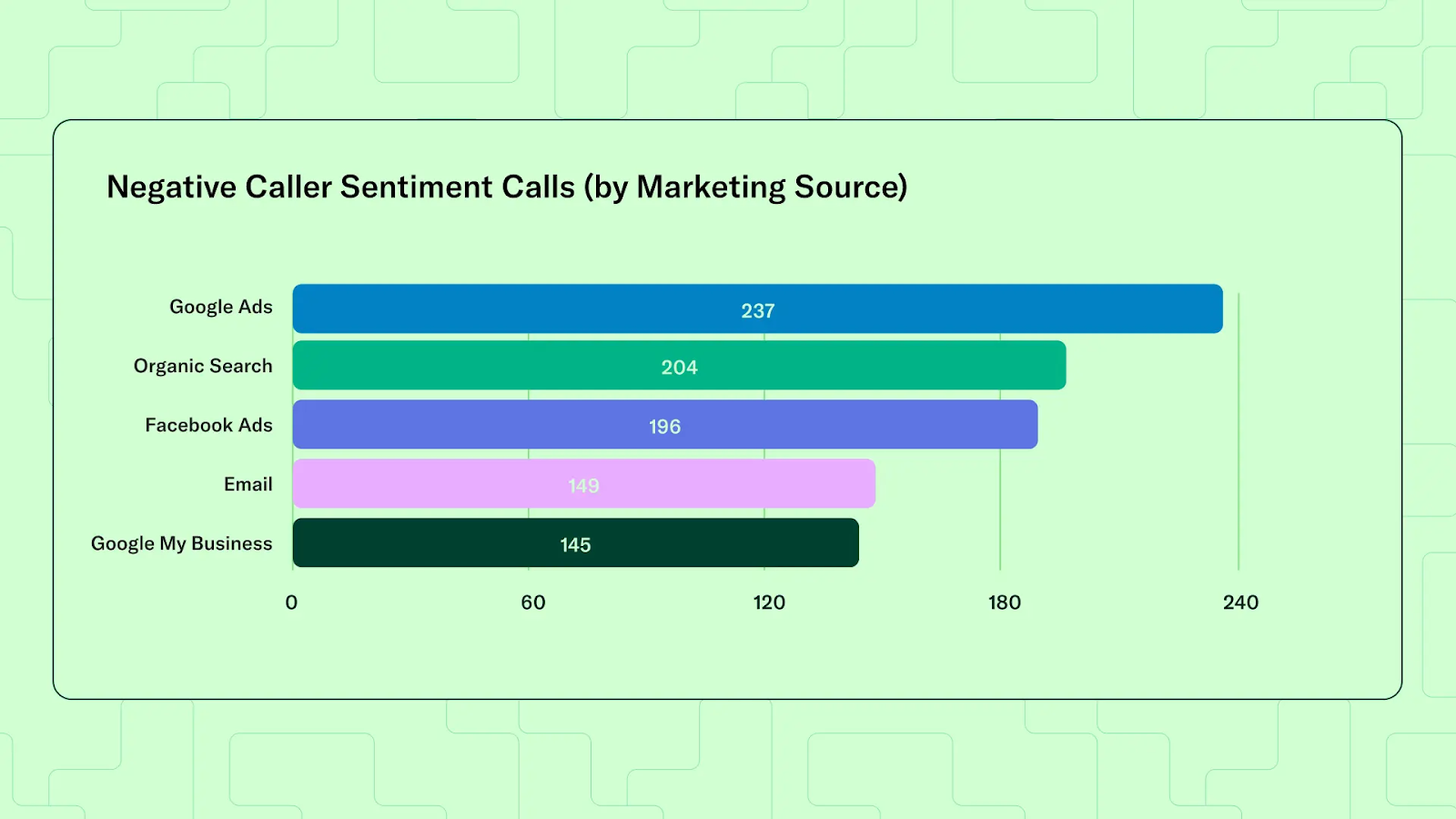Sentiment analysis — the process of identifying and analyzing subjective opinions and emotions in text — is a lot like mining for gold. You must dig deep below the surface to find the best nuggets. Artificial intelligence (AI) is the heavy-duty equipment that makes it possible. Instead of shoveling through massive datasets by hand, AI drills down quickly to deliver insights at scale, far faster and more accurately than humans ever could.
In this post, we’ll do some digging of our own. We’ll explore what AI sentiment analysis is, how it works, and highlight a few powerful tools you can use to transform raw data into customer engagement gold.
Main Takeaways
- AI can quickly analyze large volumes of customer interaction data to uncover meaningful sentiment, trends, and behaviors — insights that can inform customer experience (CX) strategy, strengthen engagement, and improve agent training.
- AI sentiment analysis ranges from basic impressions, such as whether customers have a positive, negative, or neutral view of a brand, to more complex interpretations of emotions, intent, and perceptions of products or services.
- A sentiment analysis program should be ongoing, not a one-off initiative. Using AI tools can make the process of collecting and analyzing customer insights, as well as developing actionable data, a routine part of your business.
- Choosing the right sentiment analysis model for your business is critical, as is matching your sentiment analysis approach to your CX goals. Look for solutions that offer both speech and text capabilities and ensure they fit seamlessly with your CX tech stack.
What Is AI Sentiment Analysis?
Sentiment analysis is applied in customer service, marketing, and reputation management to gauge emotions and opinions in digital text — essentially determining whether customers express positive, neutral, or negative views. It helps brands understand how they are truly perceived by customers and whether their engagement strategies are hitting the mark.
AI sentiment analysis uses natural language processing (NLP) and machine learning (ML) tools that are trained to sift through large datasets quickly and efficiently, providing timely and accurate analysis of customer sentiment. Unlike traditional methods that capture only snapshots in time, AI enables brands to continuously monitor sentiment, spotting shifts in customer perceptions as they occur.
6 Different Types of Sentiment Analysis
There are several types of sentiment analysis, each with distinct characteristics and applications. Below are six approaches brands commonly use.
1. Fine-Grained
While basic sentiment analysis classifies opinions as positive, neutral, or negative, fine-grained analysis digs deeper. It captures degrees of sentiment — such as very positive, somewhat positive, or slightly negative — to provide a more nuanced view. This approach can also identify the specific target of the sentiment, whether it’s a product feature, marketing campaign, or customer service interaction.
2. Speech-Based
Speech-based sentiment analysis is primarily used in call centers to detect customer and live agent sentiment. AI can analyze tone, pitch, and linguistic patterns and provide emotional context in live conversations. This type of sentiment analysis can provide deeper insights into customer behavior and offer valuable insights for personalization. It can also illuminate live agent performance and help inform coaching and training approaches.
3. Aspect-Based Sentiment Analysis (ABSA)
ABSA is a powerful tool for uncovering customer sentiment associated with specific parts of a product or service. For example, during a call with a home services provider, a customer might compliment a technician’s professionalism but also express frustration over a scheduling delay. ABSA separates and highlights each of these aspects, helping businesses pinpoint what’s working and where improvements are needed.
4. Emotion Detection
Emotion detection uses deep learning to identify specific emotions such as anger, joy, frustration, or satisfaction. Moving beyond basic positive, neutral, and negative categories gives brands a clearer picture of the emotional drivers behind customer interactions. These insights can fuel more personalized experiences and help agents respond with empathy, especially when customers are upset or dissatisfied with a product or service.
5. Intent-Based
Intent-based sentiment analysis, also known as sentiment intent analysis, can reveal the “why” behind a customer’s outreach. AI can analyze tone, word choice, and other conversational cues to determine whether a customer wants to make a purchase, file a complaint, request support, or cancel a service.
Applied at scale, intent-based analysis enables brands to uncover patterns in customer behavior and respond appropriately — whether that means routing calls more efficiently, prioritizing complaints, or tailoring sales conversations to match the buyer’s readiness.
6. Contextual
Contextual sentiment analysis is the deepest form of AI sentiment analysis on this list. By focusing on context, this analysis method detects complex communication styles and rhetorical tools, such as sarcasm and irony, as well as intricate language structures, to better understand sentiment within its context. AI sentiment analysis accomplishes this by analyzing longer phrases and sentences, rather than examining words in isolation.
How Sentiment Analysis Works
So, now that you have an overview of the AI sentiment analysis landscape, let’s look at how the process generally works. Here’s a rundown of the high-level steps.
Collecting and preprocessing data
AI is an incredibly powerful tool, and when it’s trained correctly, it can pinpoint and extract customer feedback from an array of digital sources. The more data you possess, the more robust and reliable the results will be.
AI easily retrieves and processes data from online reviews, social media posts, emails, texts, and other written word sources. It can even retrieve data from offline interactions, such as phone calls, using speech sentiment analysis or digitized transcripts.
Once collected, data must be preprocessed to prepare it for analysis. Preprocessing typically involves cleaning and normalizing text — for example, removing punctuation, filtering out common or irrelevant words (e.g., “the”), standardizing capitalization, and splitting sentences into individual words or phrases. This step makes the text searchable and structured, allowing AI models to detect sentiment and patterns with greater accuracy.
Classifying sentiment
Once data is cleaned and standardized, AI can begin classifying sentiment within the text. At its most basic, classification sorts content into positive, negative, or neutral categories. But the process can also go much further. Advanced approaches capture degrees of positivity or negativity, detect emotions, and even tie opinions to specific aspects of a product or service.
For example, in an auto dealership inquiry, a customer might express satisfaction with the salesperson’s knowledge but frustration with inflexible financing terms. ABSA, described in the previous section, can separate those elements, showing not only overall sentiment but also what drives customer satisfaction or dissatisfaction. Brands can use these granular insights to improve products, services, and CX.
Bringing in context
Sentiment alone doesn’t always tell the whole story. A customer response like, “This has been such a wonderful experience. Thanks for being so efficient,” sounds positive, right? However, if timestamps indicate the customer was on hold for 20 minutes, the feedback may actually be sarcastic. By analyzing longer passages and conversational cues, contextual analysis helps AI interpret sarcasm, emotional shifts, and nuanced language more accurately.
Adding speech analysis
Voice adds another dimension. With help from large language models (LLMs) and NLP, AI can evaluate the tone in customer conversations. It can analyze digital transcriptions for features such as voice, pitch, changes in speech modulation, and a speaker’s choice of words. So, if a caller suddenly starts speaking loudly in a conversation, it might indicate agitation or frustration, which might not be discernible from the speaker’s word choices.
Why Customer Sentiment Analysis Matters for Businesses
What your customers think of your business matters — and understanding those opinions should be a cornerstone of your customer engagement strategy. Sentiment analysis can help you move beyond assumptions and gather real insights into customer perceptions. When applied effectively, it can also help you to:
- Understand customer emotions more deeply. Sentiment analysis can reveal not just how customers feel, but why they respond positively or negatively to your brand, products, or services.
- Identify negative sentiment early. Customer sentiment analysis enables you to detect dissatisfaction promptly, allowing you to address issues swiftly and repair relationships.
- Optimize agent training. You can use sentiment analysis insights to guide customer service coaching and give agents the tools to respond with empathy and effectiveness.
- Enhance personalization. You can apply sentiment data in marketing and service interactions to deliver more tailored, engaging experiences.
Top Sentiment Analysis Tools for Organizations
We promised to cover some AI-driven resources that can help you gather and analyze data relevant to sentiment analysis. Here are five to consider.
Invoca
Phone calls are a rich source of customer sentiment and data, yet they’re often overlooked as such. Many customers prefer to speak to a live agent, especially if they have complex questions or are considering a high-stakes purchase.
An AI-powered platform like Invoca captures insights from 100% of calls, providing a robust dataset for customer sentiment analysis. Because Invoca integrates seamlessly with customer relationship management (CRM) systems and other key technologies, conversation insights can be combined with data from websites, chatbots, and social media to give brands a detailed and unified view of the customer journey.

MonkeyLearn
MonkeyLearn is a no-code ML platform that helps users extract sentiment and intent from tweets, chats, reviews, articles, and other raw text. It can be customized for aspect-based or contextual sentiment analysis and integrates easily with other business systems.
IBM Watson NLP
IBM Watson offers a suite of AI-powered products for text analytics. Its Natural Language Understanding (NLU) service provides advanced sentiment analysis through an intuitive interface, making it accessible to non-data scientists while still powerful enough for enterprise-scale use cases.
Google Cloud Natural Language
Google Cloud provides a pretrained Natural Language API that can analyze sentiment, syntax, and entity relationships. It’s particularly useful for developers embedding sentiment analysis into applications, as well as for marketing and customer service teams looking to evaluate customer interactions at scale.
Lexalytics
Lexalytics is an AI-powered technology that uses NLP and ML models to provide sentiment and intent analysis in 29 languages using text-based sources. It’s known for its ability to handle unstructured content, such as reviews, survey responses, and social media posts, making it a versatile tool for global organizations.
Best Practices for Using AI to Analyze Sentiment
To get the most value from AI sentiment analysis, it’s not enough to simply adopt the right tools — you need to use them strategically. Follow these five best practices to ensure your efforts deliver clear, actionable insights.
#1: Choose the Right Sentiment Analysis Model
An effective sentiment analysis program begins with selecting the right model for your business needs. For example, if you’re interested in researching customer sentiment around a new product, you’ll want an aspect-based sentiment analysis model that can deliver detailed insights concerning that product. If your program is focused on a call center function, you’ll want to use AI sentiment analysis that employs a speech-based model. Matching the model to your use case helps ensure you get insights that are both accurate and actionable.
#2: Combine Text and Voice Analysis
Today’s customers take omnichannel journeys, switching between phone calls, emails, social media, chat, and more when interacting with businesses and brands. Thus, their sentiment isn’t confined to one format — it shows up in both text and voice.
To capture the full picture, you’ll need to analyze written sources, such as reviews, posts, and emails, alongside spoken interactions from calls. AI-powered sentiment analysis tools can consolidate these inputs into a single dataset, providing a holistic view of customer sentiment across all channels.
#3: Use AI Insights
AI-driven insights can help you fine-tune marketing messages, equip sales teams with trends and behavioral cues, and amplify the true voice of the customer across your organization. These insights are especially valuable in customer support, where they can guide coaching, shape training modules, and provide agents with the tools to deliver more empathetic and effective customer service.
#4: Monitor Sentiment Trends
Customer opinions can shift quickly, and a one-time analysis won’t keep pace with them. To stay aligned with changing needs, use AI tools that enable continuous sentiment tracking. With continuous monitoring, you can spot shifts early and adjust engagement strategies promptly, keeping your business aligned with what customers care about most.
#5: Integrate AI Sentiment Analysis
Flexibility and usability depend on how well your sentiment analysis tools connect with the systems you already use. Look for solutions that integrate seamlessly with your CRM and other customer experience platforms. Full integration turns sentiment analysis from a stand-alone activity into a comprehensive CX tracking program that delivers insights across teams and drives measurable business value.
Enhance Customer Interactions and Agent Performance with Invoca
Understanding customer sentiment is crucial for enhancing engagement, and AI is becoming increasingly indispensable for uncovering detailed and timely insights from every channel.
Invoca’s AI-powered sentiment analysis can enhance any sentiment analysis program by analyzing 100% of phone conversations — not just a sample. By tracking sentiment trends over time, Invoca complements text-based analysis, providing a more comprehensive customer view.

Armed with insights from this more expansive dataset of customer interactions, your business can craft marketing messages that enhance engagement and drive revenue. You can also identify key inflection points in customer interactions to create targeted, meaningful agent training and coaching that ultimately improves the customer experience.
Additional Reading
To learn more about how AI sentiment analysis can interpret emotions, improve customer engagement, and enhance customer interactions, see these additional resources from Invoca:
- How to Uncover Competitive Data Hidden in Your Customer Calls
- What Is Call Analytics and Why Should Marketers Use It
- 5 Ways to Use Caller Sentiment Data to Improve Your Digital Marketing
To see for yourself how Invoca can enhance your customer sentiment analysis process, book a free demo with our team today.

FAQs
Can ChatGPT Do Sentiment Analysis?
Yes. You can use ChatGPT to analyze sentiment in text, from basic classifications like positive, neutral, or negative, to more advanced interpretations that account for emotions, context, and complex language patterns. Simply provide a block of text and ask for an analysis. ChatGPT can even perform sentiment analysis without prior training on your data (known as zero-shot) or with a few guiding examples (few-shot) to improve accuracy.
How Accurate Is Sentiment Analysis?
It’s widely accepted that well-trained AI models can achieve accuracy levels above 80% — comparable to the performance of human analysts. Accuracy outcomes depend on several factors, including the quality of the data, the complexity of the topic, whether the language under analysis includes sarcasm or irony, and the specific model that is used.
What Is the Best Sentiment Analysis Tool?
There isn’t a single “best” sentiment analysis tool. The right choice depends on your business goals and the type of data you need to analyze. A solution that captures both phone conversations and online interactions can provide the most comprehensive picture of customer sentiment, helping you understand not only what customers say, but also how they feel across every channel.
What Is Negative Sentiment Analysis?
Negative sentiment analysis identifies customer dissatisfaction, as captured in complaints, poor ratings, critical reviews, or negative language, across various channels, including social media and online feedback channels. Identifying negative sentiment enables businesses to pinpoint issues, respond effectively, and implement improvements to help transform unhappy customers into satisfied and loyal ones.

